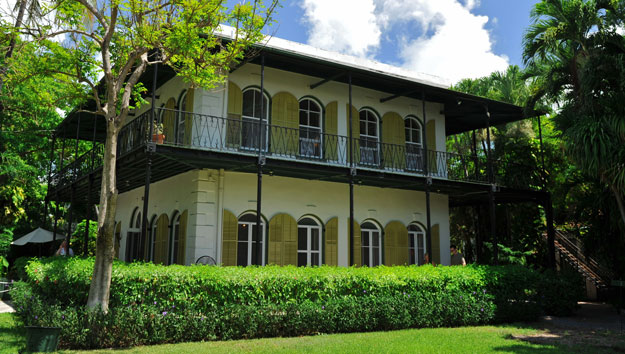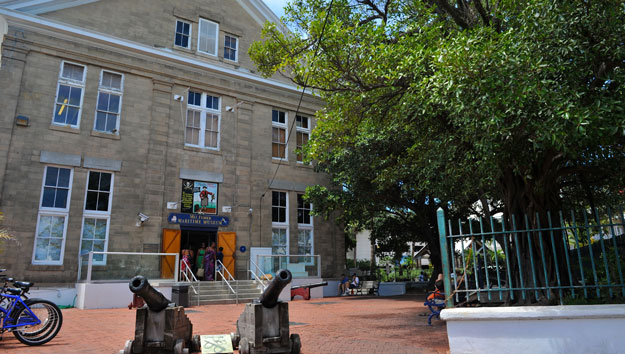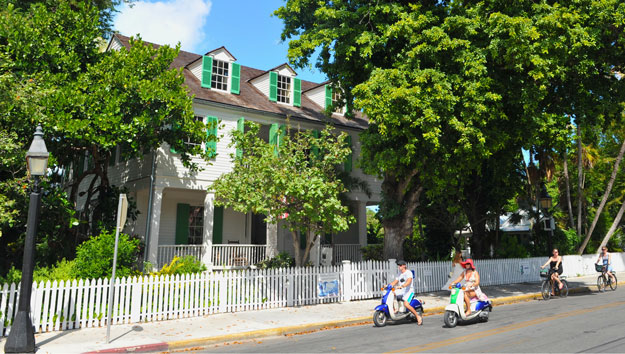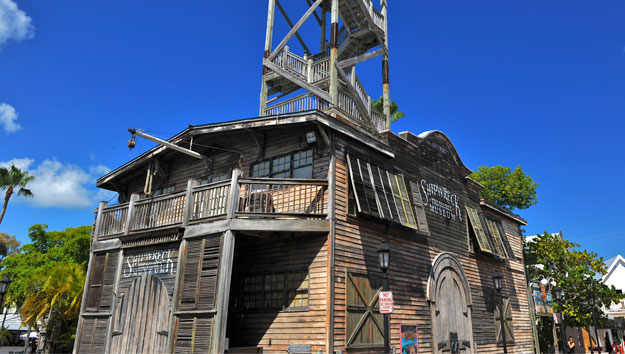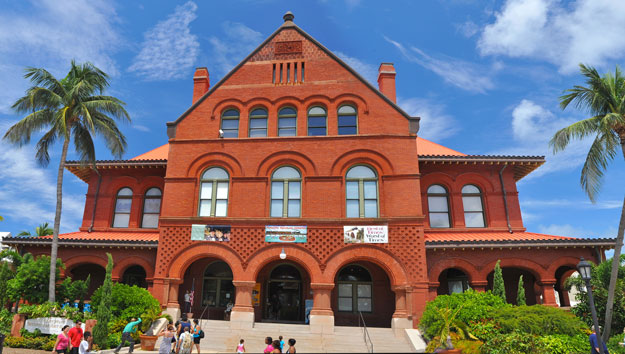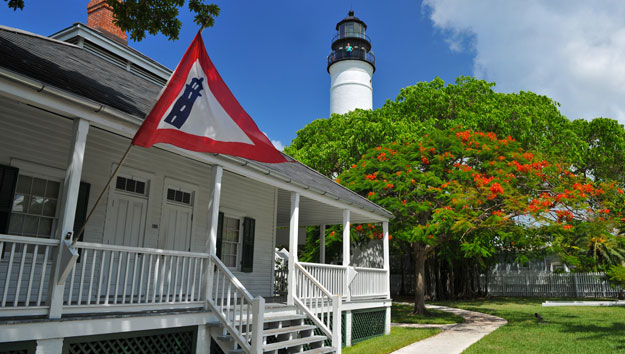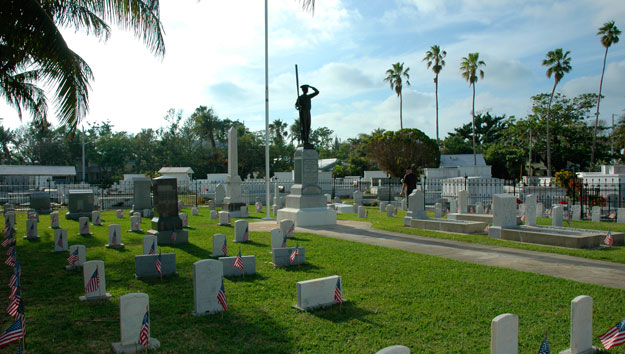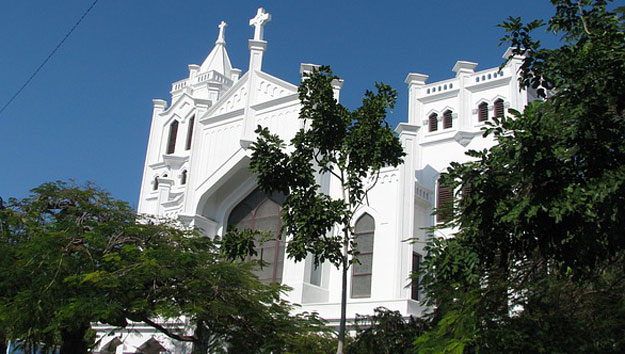Rather than being repositories of great works of art or world-class collections of artifacts, Key West museums, just like the eccentric island itself, are diverse, unusual, and intriguing. By global standards, their holdings are not impressive, however, they are places of multiple layers, each reflecting the colorful history and past of the island. The house museums, Ernest Hemingway Home, Truman Little White House, Audubon House, for example, are important on two counts: as historic buildings and for their associations with the legendary figures who resided or visited. The Customs House, East Martello Museum, Mel Fisher Museum, Lighthouse Museum too, each important historical structures in their own right also house interesting and diverse exhibits.
Ernest Hemingway Home & Museum
Uninhibited, tropical, comfortable, a place to just be, Key West has a long attracted writers and artists. It is the island way to let famous residents and visitors blend in anonymously, without fawning, fanfare or photo ops. Arguably the island’s most notable resident, literary giant Ernest Hemingway, found Key West to be his place to be between 1931 and 1940. He wrote, fished and freely enjoyed the camaraderie of local politicians, fishermen, businessmen and wreckers.
Hemingway and his second of four wives, Pauline, first came to Key West in 1928, staying on the island for 3 weeks while waiting on a car delivery. During this time, while living in a flat above the car dealership, Hemingway completed A Farewell to Arms and enjoyed the island’s feel, lifestyle and people. This was enough of a taste to make them decide to make this their permanent home. They found the large, Spanish Colonial limestone house on Whitehead Street, within sight of the Southernmost Point, built by salvage wrecker Asa Tift in 1851, in a state of disrepair, but they liked it. The house was purchased for them by Pauline’s Uncle Gus. A massive restoration was undertaken, which included the installation of a large poo, unheard of in Key West at the time. Hemingway, Pauline and their two sons, Patrick and Gregory, lived together in the house until Hemingway left permanently for Cuba in 1940. Pauline and the boys continued to live in the house until 1951.
The house is much as it was when they lived there. Over time, it has taken on the legendary status of its famous resident. While the interior contains some Hemingway memorabilia, many furniture pieces and chandeliers came from Pauline’s collection shipped from Paris, where the couple lived, met and married in the 1920s. Highlights for many visitors: the studio in which Hemingway did his early morning writing and the large number of six-toed cats seen around the home and extensive grounds, most of which are descendants of the cats Hemingway kept while living there.
Harry S. Truman Little White House
The large, frame venacular 8700 square foot Truman Little White House, built in 1890 by the U.S. Navy as a duplex to house officers and simply known as Officers Quarters A&B, has had multiple lives. However, it is best known as the “Little White House,” where President Harry Truman spent 11 working vacations between 1946 and 1952, when it was Navy property, which it remained until 1977. It comes as a surprise to some that the Navy has always had a presence in Key West. Key West and the Navy go way back to 1823 in an association that continues today. The reasons: strategic location and deepwater harbor. Over this almost 200 years long long history, the Navy’s presence on the island has expanded and contracted depending on global events. When Truman first arrived in 1946, in the aftermath of WWII, the presence was huge. It was a large, active submarine and anti-submarine facility with destroyers and subs in its harbor and planes and blimps on its airfield.
The intensity of end of the war decisions and events took its toll and Truman and his doctor ordered rest. At the time, there was no Camp David, and Admiral Nimitz served up vacant Officers Quarters A&B as a presidential retreat. Despite its size, the residence was Navy issue plain. It was the perfect place for the plain-spoken president from Missouri, a man of simple taste. Although made more comfortable for his subsequent stays with his family and staff, the simplicity of this president’s lifestyle is evident in the faithfully restored house. Entering the home is instant time warp! Guided tours go through the entire home, looking just as it was during Truman’s visits. Guides tell stories in every room and point out carefully curated items of interest, much of it collected in recent years. Small rooms just beyond the gift shop display memorabilia of this house in which history happened. Photographs lining walls are a testament to the role of the Little White House as a place where national and international leaders have visited, met and resided. The list is formidable. Remarkably, the Little White House is not a static place. Its distinguished legacy as a gathering place of international leaders continues today.
Mel Fisher Treasure Museum
Who is not fascinated by treasure and treasure hunters? Real treasure found by real treasure hunters is all here, inside Mel Fisher Museum – sunken treasure retrieved from the wrecks of two Spanish galleons travelling as part of the Spanish Armada’s 1622 Fleet. On exhibit at the museum is a significant treasure trove from the Nuestra Senora de Atocha and Santa Margarita – gold, silver, gems, gold chalices, plates, necklaces, large chains and belts plus interesting artifacts – tools, navigational instruments, pottery utensils, armaments, household and personal items – offering insight into life in the 17th century. These treasures and more not on display were found buried in the shifting sands in the waters off Key West by Mel Fisher and his crew after a 16 year quest. In telling the story, the passion, dedication, inventiveness and sacrifice of treasure hunters resonates. In addition to these treasures, other compelling exhibits offer a sobering look into Key West’s unusual role in the transatlantic slave trade; separate fact from fiction in the role of pirates who plied the Florida Keys; provide an understanding of the science of how ships on their way up the Gulf Stream rammed into the Florida Reef.
Audubon House and Tropical Gardens
Before it was called the Audubon House, this beautifully restored home, was built in the 1840s by prominent salvage wrecker, Captain John Geiger, as his family home. For over a century the home past down through Geiger descendants. Scheduled for demolition in 1958, it was rescued by the Mitchell Wolfson Family Foundation, an act that sparked Key West’s restoration movement. Carefully restored, the Geiger home was opened in 1960 as a museum, under a new name: The Audubon House. Although the famed naturalist never stayed in the home, John James Audubon’s 1832 visit to the island and his discovery of 22 new bird species while here, was commemorated with the opening of the house museum, now bearing his name.
A mansion in its day, the home and fine period furnishings reflect the comfortable lifestyle of the wealthy Key West families in the mid-1800s, whose fortunes were made through the salvaging of merchant ships wrecked on the offshore reef. In tribute to Audubon, there is also an extensive collection of hand-painted lithographs by the famed naturalists. Guests can roam through the house and colorful tropical gardens at their leisure. Here’s some trivia: the Geiger Home is said to be haunted – one of the many in Old Town in which strange sightings have occurred!
Shipwreck Treasure Museum
This museum is not an historic site, but it sure looks like one. Although built from the ground up, it has the aged look of an 1850’s wreckers warehouse, complete with a wrecking tower. It’s an immersive experience. No detail is spared inside to make it feel like mid 19th century maritime salvage warehouse. Through actors dressed in period clothing and exhibits of salvaged artifacts from the merchant vessel, the Isaac Allerton, the story of the wrecking industry is told. Unknown to most people outside of Key West, wrecking, or the legal salvaging of cargo from vessels wrecked along the length of the Florida Reef just a few miles offshore, was a lucrative business. In the mid 1800s, wrecking earned the tiny island community the status of the richest city per capita in the U.S! Besides learning about wreckers, you can lift a silver bar and, best of all, climb up the tower where the 360 degree view is magnificent. Look all around, from Atlantic to the Gulf. Ring the bell. Yell “Wreck Ashore!”
The Custom House/Key West Art & Historical Museum
Oddly different from the pastel quaintness of Key West’s collection of restored historic houses, the massive, red brick Romanesque style building on Front Street stands out. The huge, whimsical Seward Johnson statues around the exterior stop passersby in their tracks. But the building is so imposing people often take their photos and walk on. They shouldn’t. Built as a Federal government building in 1891 to house the island’s customs office, post office and District Court, it was built to handle the demands of the growing and lucrative maritime trades. It was also the site of the inquiry into the sinking of the USS Maine in Havana Harbor. The interior with soaring ceilings, grand wood staircases and huge expanses of crown moulding, is wonderful; the art and historical artifact collections on exhibit, focusing on Key West life, people and events, past and present, both permanent and traveling, even better.
Key West Lighthouse & Keepers Quarters Museum
Essential for the safe navigation into the harbor through the treacherous reef prior to navigational technology, the Key West Lighthouse on the corner of Whitehead and Truman, opened it 1848. Its Keeper was a woman, Barbara Mabrity, who took over as Keeper of the original lighthouse in 1932 following the death of her husband. After the original lighthouse was destroyed in the Great Havana hurricane of 1846, Barbara she resumed her post at the new lighthouse when it was completed. Over time, the lighthouse underwent necessary upgrades including the installation of a Third Oder Fresnel Lens, and extension to the tower, an addition of the Keeper’s Quarters, and the electrification of the light. Functionally obsolete in 1969, it was decommissioned and stands today as a dedication to the island’s maritime heritage and lighthouse Keepers everywhere. Walk the 88 steps to the top for a wonderful view of the island and out into the Atlantic; see how lighthouse Keepers and their families lived inside the Keepers Quarters. While this lighthouse was not totally isolated, many around the coast are. They represent a world and a life unto themselves.
Oldest House
The 1829 home of Captain Frances Watlington and his family comes by its name rightfully. It’s the oldest house in South Florida. Like most of the island’s population at the time, Captain Watlington was involved in the maritime industry, as Customs Inspector, Lightship Captain and harbor pilot. He lived in the simple home which incorporates the colonial architecture of both the Caribbean and New England, the two major cultural influences of historic Key West. The interior has period furnishings, in much the same style as the Geiger home, as well as nautical artifacts. How the family of nine daughters lived in the small house is astounding. Having a separate cookhouse out back in the long rear garden helped. Common for safety reasons in the days of open-flame cooking, not having to cook inside kept houses cooler. On a lighter note, the Watlington house is also said to be haunted!
Key West Cemetery
Not a museum in the traditional sense, the island’s cemetery is, in a sense, an outdoor museum, considering the generations of “Conchs” buried there. After the original burying ground near the Southernmost Point was uprooted and flooded in the hurricane of 1847, the city established 16 acres of “high ground,” 10 feet above sea level, in the center of the island. Because the island’s substrate is limestone, burying deep is not possible. Vaults are above-ground and white-washed. Family plots can be complicated structures. Gravestones tell Key West’s colorful history, and epitaphs on some are as eccentric as the island itself. Standing out prominently in the low-scale cemetery is the USS Maine Memorial, the burial ground for at least 19 or more remains of the crew who perished aboard the ship when it exploded and sank in Havana Harbor on February 15, 1898. Walk through on your own or book a guided cemetery tour to see all the interesting details. Wear sunscreen as there’s not much shade. Bring a camera. Be prepared to encounter large iguanas lounging on the warm gravestones! And chickens scratching about too!
St. Paul’s Church
The first Episcopal Church in South Florida established a congregation in Key West on Christmas Day in 1832. Having no church building at the time, the congregation held its first service in Jackson Square. After 3 churches built on the same site on the corner of Duval and Eaton Streets were destroyed by hurricanes, the 4th and present church, completed in 1916, incorporated some of the stained glass saved from earlier structures. Although St. Paul’s is not a museum, it holds a lot of island history as many prominent early residents worshiped there and contributed to its lovely interior elements and beautiful stained glass windows. It’s a must see spot walking along Duval Street.
East Martello Museum
All the way around, this museum is a funky, oddly Key West place, combining an interesting Civil War era fort which saw no action, an eclectic collection of Key West-centric artifacts, none related to the Civil War, and a supernatural draw. The artifacts are housed inside the fort casements, which is really cool! Besides being able to wander through an old fort looking at assorted artifacts, and out on the parade ground, the main event is the supernatural star who lives here – Robert the Doll! Globally known, and sought after by ghost hunters, this is no ordinary rag doll. Walking into Robert’s space for the first time is eerie. He’s big for a doll, at first glance looks sweetly innocent, but those beady button eyes are something else! Stare at him long enough and it feels as though his eyes are following you without moving. Be nice to Robert. Bring your camera. Warning: if you take his picture, be sure to ask him first…or else! To see Robert at night and experience the “other,” haunted side of Key West, go on a Ghosts & Gravestones Tour.


